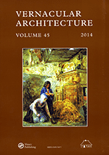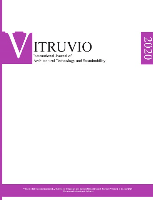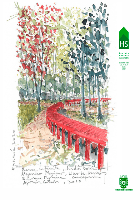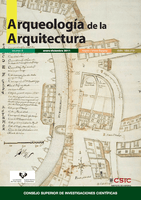
Vernacular Architecture
Scope & Guideline
Illuminating the Intersection of Culture and Construction
Introduction
Aims and Scopes
- Documentation of Vernacular Building Types:
The journal emphasizes the importance of cataloging various types of vernacular buildings, including timber-framed structures and traditional houses, to preserve architectural heritage and inform future conservation efforts. - Historical and Archaeological Analysis:
Research often involves historical context and archaeological findings to explore how vernacular architecture has evolved over time, providing insights into the social, economic, and environmental factors influencing building practices. - Cultural Heritage and Identity:
A consistent focus is placed on how vernacular architecture contributes to cultural identity and heritage, examining the narratives associated with traditional structures and their significance to local communities. - Interdisciplinary Approaches:
The journal employs a range of methodologies, including dendrochronology, historical research, and architectural analysis, to explore the multifaceted aspects of vernacular architecture. - Regional Studies:
The journal showcases studies from various geographical regions, demonstrating the diversity of vernacular architecture and its adaptation to different environmental and cultural contexts.
Trending and Emerging
- Sustainability and Eco-friendly Building Practices:
Recent publications increasingly focus on sustainable building materials and techniques used in traditional architecture, addressing contemporary issues of environmental conservation and climate change. - Digital Heritage and Archiving:
The use of digital tools for documenting and analyzing vernacular architecture is gaining traction, reflecting an emerging interest in how technology can enhance preservation efforts and accessibility. - Community Engagement in Preservation Efforts:
There is a rising trend towards involving local communities in the documentation and preservation of their architectural heritage, emphasizing participatory approaches and local knowledge. - Cross-Cultural Comparisons:
Emerging studies are beginning to draw comparisons between vernacular architectures in different cultural contexts, highlighting global influences and shared practices that transcend local boundaries. - Gender Perspectives in Vernacular Studies:
Increasingly, research is exploring the role of gender in vernacular architecture, focusing on how women’s contributions and experiences are represented in the built environment.
Declining or Waning
- Urban Vernacular Architecture:
While urban vernacular architecture was once a prominent theme, recent issues have shifted focus more towards rural and traditional buildings, possibly due to a growing interest in rural heritage preservation. - Modern Adaptations of Vernacular Styles:
The exploration of contemporary interpretations and adaptations of vernacular styles has decreased, indicating a possible preference for historical perspectives rather than modern adaptations. - Influence of Industrialization on Vernacular Practices:
There has been less emphasis on examining the impact of industrialization on traditional building practices, which may suggest a move towards more localized studies rather than broader socio-economic influences.
Similar Journals

Bulletin KNOB
Advancing Knowledge in Arts and HistoryBulletin KNOB, published by the KONINKLIJKE NEDERLANDSE OUDHEIDKUNDIGE BOND-KNOB, is a reputable Open Access journal that has been disseminating knowledge since 1899, with a continued commitment to making research accessible to all. Based in the Netherlands, this journal provides a platform for scholarly articles that span the fields of Conservation, History, and the Visual Arts and Performing Arts. With its 2023 Scopus rankings placing it in the top quartiles within its category, Bulletin KNOB is recognized for its significant contribution to the advancement of these disciplines. Researchers, professionals, and students alike are encouraged to engage with the journal's diverse content that bridges historical narratives with contemporary practices, fostering a deeper understanding of cultural heritage. The journal’s commitment to excellence is further reflected in its Q3 and Q4 quartile rankings, making it an essential resource for anyone dedicated to the study of the arts and humanities.

VITRUVIO-International Journal of Architectural Technology and Sustainability
Transforming ideas into sustainable architectural realities.Welcome to the VITRUVIO-International Journal of Architectural Technology and Sustainability, a leading open-access journal published by UNIV POLITECNICA VALENCIA, EDITORIAL UPV since 2015 and based in Spain. With its ISSN 2444-9091, this journal is dedicated to advancing the field of architectural technology and sustainability, providing a vital platform for researchers, professionals, and students alike. The journal has made significant strides in the academic landscape, achieving a Q3 ranking in Architecture and a Q4 ranking in Building and Construction for 2023. It features a diverse range of scholarly articles that explore innovative practices, cutting-edge research, and sustainable solutions in architecture. With a Scopus ranking placing it at #70/189 in Architecture and #161/223 in Building and Construction, it is positioned within the 63rd percentile and 28th percentile respectively, demonstrating its increasing impact in these vital fields. We invite you to engage with our content and contribute to the ongoing discourse around sustainability in architectural practice.

TRANSACTIONS OF THE ANCIENT MONUMENTS SOCIETY
Engaging with the Timelessness of HeritageTRANSACTIONS OF THE ANCIENT MONUMENTS SOCIETY is a distinguished journal published by the Ancient Monuments Society in the United Kingdom, focusing on the rich interplay between architecture, conservation, and religious studies as they pertain to ancient monuments and heritage. With an ISSN of 0951-001X, this journal serves as an essential platform for researchers, professionals, and students interested in exploring methodologies, case studies, and theoretical perspectives that enhance our understanding of historical preservation and cultural significance. Although it has been classified in Q4 quartiles in prominent categories such as Architecture, Conservation, and Religious Studies, the journal plays a vital role in fostering scholarly dialogue in these areas. Access options and updates are available, making it easier for enthusiasts and experts alike to engage with ongoing discussions surrounding ancient monuments. Despite its discontinued coverage in Scopus, the journal remains an invaluable resource for those aiming to contribute to the conservation discourse and to understand the relevance of ancient sites in contemporary society.

Architecture and Culture
Bridging Architecture and Cultural NarrativesArchitecture and Culture is an esteemed journal published by Routledge Journals, Taylor & Francis Ltd, focusing on the intersection of architecture, cultural studies, urbanism, and the visual and performing arts. Since its inception, this journal has become a vital platform for researchers, professionals, and students to explore the multifaceted relationship between architecture and cultural identity within contemporary contexts. With an ISSN of 2050-7828 and an E-ISSN of 2050-7836, the journal reaches a global audience from its base in the United Kingdom. Featuring a commendable Q2 ranking in Visual Arts and Performing Arts and a consistent presence in multiple relevant quartiles, including Q3 in both Architecture and Cultural Studies, it is well-regarded for its scholarly impact. The journal offers a unique opportunity for interdisciplinary dialogue, fostering innovative research that examines how built environments shape and are shaped by cultural narratives. This commitment to advancing knowledge in these fields is reflected in its ongoing publication from 2014 to 2024, making it a pivotal resource for those at the forefront of the discourse on architecture and culture.

Revista Habitat Sustentable
Empowering Change through Sustainable Habitat InsightsRevista Habitat Sustentable, published by UNIV BIO-BIO in Chile, is a dynamic open access journal that has been contributing to the fields of architecture, engineering, and sustainable development since its establishment in 2011. With an ISSN of 0719-0700, this scholarly platform stands out for its commitment to disseminating high-quality research that addresses pressing issues in sustainability and urban planning. Currently, it holds commendable rankings in several categories, including Q2 in Architecture and Q3 in Urban Studies, reflecting its growing influence and outreach across various disciplines. The journal's mission is to foster interdisciplinary dialogue and encourage innovative approaches to habitat sustainability, making it an essential resource for researchers, professionals, and students engaged in addressing the complex challenges of our built environment. Accessible to a global audience, the Revista Habitat Sustentable is poised to play a pivotal role in shaping future research and policy in sustainable living and development.

Arqueologia de la Arquitectura
Unveiling Architectural Narratives Through TimeArqueologia de la Arquitectura is a premier scholarly journal published by CONSEJO SUPERIOR INVESTIGACIONES CIENTIFICAS-CSIC, specializing in the intricate intersections of architecture, archaeology, and conservation. Since its inception in 2002, this Open Access journal has provided researchers, professionals, and students with a platform to share innovative findings that deepen our understanding of architectural heritage and its archaeological contexts. Based in Spain, it has demonstrated remarkable academic rigor and impact, achieving Q1 rankings in multiple categories, including Architecture and Visual Arts and Performing Arts, alongside a Q2 in Archaeology as of 2023. With a robust presence in Scopus, ranking within the 88th percentile for Visual Arts and Performing Arts, Arqueologia de la Arquitectura stands as a crucial resource for those dedicated to the preservation and study of our built heritage, encouraging interdisciplinary dialogue and research advancements in these elegant fields of study.

En Blanco-Revista de Arquitectura
Exploring the Intersection of Theory and Practice in ArchitectureEn Blanco - Revista de Arquitectura is a peer-reviewed journal published by UNIV POLITECNICA VALENCIA, EDITORIAL UPV, specializing in the field of architecture and design. This esteemed publication aims to bridge theoretical advances and practical applications within the architecture domain, showcasing innovative research, critical essays, and multidisciplinary approaches. With an emphasis on fostering dialogue among researchers, professionals, and students, En Blanco serves as an essential platform for disseminating cutting-edge ideas and discussions that define contemporary architectural practices. Although currently offering non-open access content, the journal is dedicated to promoting accessibility through insights that resonate beyond its pages. With an ISSN of 1888-5616 and E-ISSN of 2445-1215, En Blanco is a pivotal resource for any architecture enthusiast looking to enrich their understanding and contribute to the evolving discourse in architectural studies.

ARCHITECTURAL HISTORY
Illuminating the Intersection of History and DesignARCHITECTURAL HISTORY is a renowned journal published by Cambridge University Press, dedicated to advancing the field of architecture through scholarly research and critical analysis. Operating under ISSN 0066-622X and E-ISSN 2059-5670, this academic journal plays a pivotal role in disseminating knowledge related to the historical and theoretical dimensions of architecture. Though currently not open access, it offers invaluable insights for researchers and professionals interested in the evolution of architectural practices, spanning from the year 2002 to 2009 and continuing from 2011 to 2023. With a Q4 ranking in Architecture and a Q3 ranking in Visual Arts and Performing Arts as of 2023, ARCHITECTURAL HISTORY is well-positioned to contribute to the ongoing discourse in these fields. Furthermore, it holds commendable placements within the Scopus rankings, specifically 322/667 in Visual Arts and Performing Arts and 139/189 in Architecture, reflecting its growing influence. This journal serves not only as a platform for in-depth research but also as a critical space for scholarly exchange, making it an essential resource for students and academics alike who aspire to deepen their understanding of architectural heritage and its impact on contemporary practices.

Journal of Historic Buildings and Places
Bridging History and Modernity in Building Conservation.The Journal of Historic Buildings and Places, published by the esteemed Ancient Monuments Society, is a pivotal platform dedicated to advancing the study and preservation of historic architecture and cultural heritage. With an ISSN of 2753-2453, this journal serves as a sanctuary for researchers, professionals, and students who are passionate about exploring the significance of historic buildings, landscapes, and places. Its commitment to open access publication ensures that critical findings in the field are readily available to a global audience, thus facilitating wider dissemination of knowledge and fostering collaborative engagements among scholars. The journal contributes significantly to the ongoing discourse on conservation practices, architectural history, and heritage management, making it an essential resource for anyone committed to the study and preservation of our architectural legacy.

ArcHistoR-Architecture History Restoration
Exploring the Intersection of Architecture and HistoryArcHistoR-Architecture History Restoration is an esteemed open-access journal published by UNIV MEDITERRANEA REGGIO CALABRIA since 2014, focused on the multifaceted domains of architecture, history, and visual arts. This journal serves as a vital platform for the dissemination of research findings, innovative methodologies, and critical discussions surrounding the restoration and history of architectural practices, appealing to a diverse audience of researchers, professionals, and students in these fields. With a commitment to scholarly excellence, ArcHistoR has positioned itself within the academic community, reflected in its ranking in the 2023 category quartiles, where it secured Q4 in Architecture and Q3 in both History and Visual Arts and Performing Arts. The journal facilitates global collaboration and knowledge sharing in its areas of expertise, further underscoring its relevance and significance. Based in Italy, effective communication and cooperation in the restoration community can flourish through the journal's purview. For those dedicated to expanding their understanding and contributing to the discourse on architectural history and restoration, ArcHistoR is an invaluable resource.